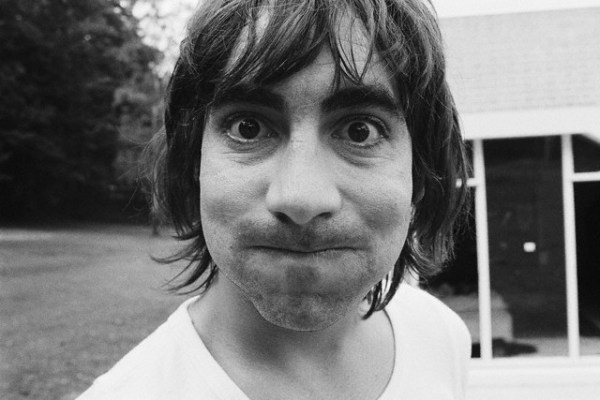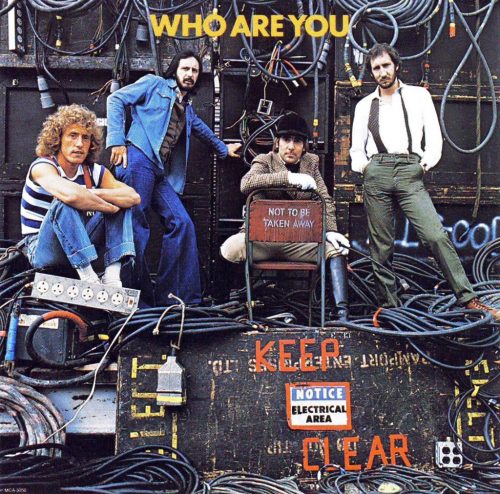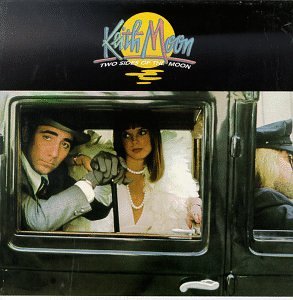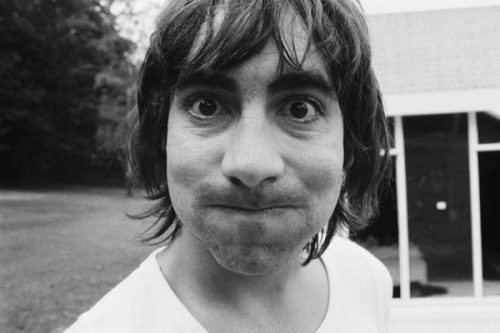 You can celebrate Keith Moon’s birthday on August 23 a couple of different ways. You can go out and cause some mischief, as Moon often did. Consider this escapade: Moon and his buddies cruised neighborhoods in his Bentley and issued a warning on a loud PA, using proper upper-class diction, speaking as a declared “Conservative candidate for Parliament”: “A boatload of refugees is about to move into the neighborhood.” You can’t help but laugh at Moonie’s piss-take. (Imagine that prank today.)
You can celebrate Keith Moon’s birthday on August 23 a couple of different ways. You can go out and cause some mischief, as Moon often did. Consider this escapade: Moon and his buddies cruised neighborhoods in his Bentley and issued a warning on a loud PA, using proper upper-class diction, speaking as a declared “Conservative candidate for Parliament”: “A boatload of refugees is about to move into the neighborhood.” You can’t help but laugh at Moonie’s piss-take. (Imagine that prank today.)
Or you could have celebrated the fact that Moon was, quite possibly, the most sensational drummer in rock history, even if he never thought of himself as just the drummer in a rock ’n’ roll rhythm section. He wasn’t support; Moon thought what he played with The Who was “lead drums.”
The Foo Fighters’ Dave Grohl is one believer. In an NME story, Grohl said, “Keith Moon played like he was on fire. He was a wild drummer. He was sloppy and he was fuckin’ frenetic and manic, but that’s The Who.”
Here’s The Who’s legendary appearance on The Smothers Brothers Show. Tommy Smothers: “And over here the guy who plays the sloppy drums…”
However you chose to celebrate, you just wouldn’t want to do a full Moon. Certainly, not what Moon did the night of September 6, 1978. He went to a London party hosted by Paul McCartney, celebrating the movie The Buddy Holly Story. Moon snorted a bit of cocaine beforehand, but drank surprisingly little. Still, he was slurry—the result, it turned out, of a prescription drug called Heminevrin, used in the treatment of alcoholism. The drug mimicked alcohol’s effects; used with alcohol, as it shouldn’t be, it multiplied them.
Moon and his girlfriend Annette Walter-Lax left the party early, around midnight. After dining, she said, he had “his usual glass of water and bucket of pills.” Moon woke up one more time, early in the morning, and demanded she cook him a steak. He ate and went back to sleep. That was it. An autopsy revealed 32 Heminevrin pills in his system.
 And thus, a year after Elvis’ death, Keith Moon died before he got old, a decade younger than the King. On the cover of the final Who album with him, Who Are You, Moon is pictured sitting backwards in a director’s chair with the words NOT TO BE TAKEN AWAY emblazoned on it. The album was released less than a month before his death.
And thus, a year after Elvis’ death, Keith Moon died before he got old, a decade younger than the King. On the cover of the final Who album with him, Who Are You, Moon is pictured sitting backwards in a director’s chair with the words NOT TO BE TAKEN AWAY emblazoned on it. The album was released less than a month before his death.
Two weeks before the album’s release, Moon and Pete Townshend did a live interview on ABC-TV’s Good Morning America. It’s amazing to watch for a lot of reasons—not the least of which is GMA host David Hartman’s general awkwardness. How was Moon awake at that “early” hour? The warm relationship between the two members is wonderful to behold. The interview begins at the 47:30 mark…
Many have been influenced by Keith Moon; some—to mixed results—have tried to imitate him. Townshend has called [current and longtime Who drummer] Zak Starkey “the karmic Keith Moon.” Starkey (the son of Ringo Starr) considered Moon like an “uncle” and was given his first drum set by him. But even he has said that there was only one Moonie.

“I never actually sat at a set of drums with Keith,” Starkey told Modern Drummer. “We used to talk about the drums. I asked him how he played the ride cymbal part in ‘Glow Girl’ from Odds & Sods. It’s an incredibly fast ride cymbal. He said what he did was put up one cymbal and a piece of cork where the wing nut would go, then another cymbal on top of that, but upside down. And he played between the two. That’s the only advice he gave me, and I think he may have lied. The recording sounds like an overdub to me. …When I first played with The Who we did Quadrophenia. There were certain things that had to be in there, certain fills that had to be exactly the same because they are so Quadrophenia, if you know what I mean. They are memorable fills. There aren’t memorable parts, though, because everything Keith played kept changing. If you listen to ‘The Real Me,’ you’re not quite playing the same thing every time, ever. Every bar comes around again, but what he played was never the exact same thing.”
Related: That time Moon passed out onstage and was replaced by a Who fan
“He had a very weird style of playing,” the late Who bassist John Entwistle told MOJO’s Rob Chapman. “He started his drum breaks with his left hand: most drummers operate with their right. And he wouldn’t play across his kit: he’d play zig-zag. That’s why he had two sets of tom-toms. He’d move his arms forward like a skier. He fitted in with my bass style perfectly. I was overjoyed because I could get my rocks off with him. Keith’s style really developed after he got more drums: once he got a really big kit with two bass drums, that’s when he really started shining. And that’s when he really helped develop my style as well. I had to find a way of playing twice as fast to fit in with his double bass-drum patterns. He played triplets so I had to devise a way of playing triplets with him rather than just stand there and plonk away.”
Roger Daltrey added, “Pete had developed this kind of rhythmic-lead style of playing and John was already playing completely different bass than anybody else. He was already playing 25 times as many bass notes as anybody else played in a bar. But Keith just molded into it. He was just right.”
Here’s the band’s live performance of “Baba O’Riley,” taped for the 1979 documentary The Kids Are Alright.
Related: An eyewitness remembers the Who’s NYC debut
In 1975, Moon got to make a solo album. Hell, Townshend, Daltrey and Entwistle had done so, why not Moon? He couldn’t sing, really, his voice was more of a croak or a bark, one we heard on Quadrophenia when he sang “Bell Boy.”
That barely mattered for Two Sides of the Moon. A cast of his famous friends was assembled to back him as he took the mic. Recording costs went through the roof. He has drum credits on only three tracks. Drummer?! That was his job. Critic Robert Christgau was not wrong when he called it an “alternately vulgar, silly and tender travesty/tour de force.”
It all happened in L.A. He went to California, the way many a pasty Brit did when they had the ways and means. He joined the (then merry) band of rock ’n’ roll drinkers and druggies: John Lennon, Alice Cooper, Ringo Starr, Harry Nilsson, Marc Bolan and others—the Hollywood Vampires, the name Cooper later took for his current side project.
The album is a lark. Moon loved the Beach Boys more than anything—the Who covered “Barbara Ann”—and sang a wonderfully wobbly “Don’t Worry Baby,” which purists heard as sacrilege.
Lennon gave him the rip-snorting album kickoff, “Move Over Ms. L,” and Nilsson, Ringo and Moon collaborated on the joyously sad sing-along song of bonding and breaking apart, “Together.” (There’s a fab Monty Python-esque joke exchange at the end.)
 The LP design featured a cutout rectangle on the front and when you slid in the inner sleeve, you either saw a formal Moon in a top hat, peering out a limo window as a beautiful lady friend behind him gazes at him fondly. Or you saw Moon’s ass, as the clown that he could be mooning us through the limo window. (I think it’s Moon’s but it’s suspiciously non-hairy.)
The LP design featured a cutout rectangle on the front and when you slid in the inner sleeve, you either saw a formal Moon in a top hat, peering out a limo window as a beautiful lady friend behind him gazes at him fondly. Or you saw Moon’s ass, as the clown that he could be mooning us through the limo window. (I think it’s Moon’s but it’s suspiciously non-hairy.)
“I suppose to most people I’m probably seen as an amiable idiot…a genial twit,” Moon told Rolling Stone in 1972, talking with glee about the pleasure he derived from performing practical jokes on himself and others. “Of course,” he added in a rare moment of semi-reflection, “the biggest danger is becoming a parody.”
There are two great, differently slanted, biographies. The first, 1981’s Full Moon, by Dougal Butler, Moon’s personal assistant, makes the tales of Moon’s life seem like a near constant spit-take. I have to admit to laughing out loud when I read about Moon encountering a bowl of pills at a party and just gobbling up a handful, whatever they might have been, because, well, that’s what crazy-ass rock ’n’ roll drummers do, come hell or high water.
But then, in 2000, came Tony Fletcher’s Dear Boy: The Life and Death of a Rock Legend. While drawing upon some of the same material, Fletcher painted a far darker picture, where the fun and games was not just fun and games, where Moon’s behavior was often pathological.
Fletcher suggests Moon likely suffered from bipolarity. (Multiple personality disorder is another speculative diagnosis.) The youngest member of the Who, Moon was certainly the most dysfunctional member of that highly dysfunctional musical family. He was not, on the surface, a complicated man (his core philosophy was hedonism), but he was a contradictory one.
Watch this memorable performance of “A Quick One (While He’s Away)”
If you’re a new Best Classic Bands reader, we’d be grateful if you would Like our Facebook page and/or bookmark our Home page.
It gets harrowing when Moon tries to chop down the door to the bathroom to get at his wife, Kim, a la Jack Nicholson in The Shining. There’s the story of Moon being quite likely at the wheel of a car that ran over and killed a member of his entourage, Neil Boland. (Moon was legally cleared, but guilty in his own mind, Fletcher writes.)
Moon’s life was one where the gleeful exuberance and miscreant nature of youth gradually hardened into something harsher and meaner, though still, not without charm. You can’t pinpoint the moment the trajectory started to head downhill. And the fact is, through thick and thin Moon’s humor often came poking through. He relished sending up the opulent rock-star lifestyle while he simultaneously indulged in it.
Moon saw life as performance art, every day a dress rehearsal. His humor could go over the edge. Throughout his life he favored Nazi regalia. He’d dress up as Rommel in jodhpurs, binoculars, knee boots, leather coat and cap and march up and down the beach. Or show up like that at a business meeting. He had an overwhelming desire to get messed up. He snorted heroin once, didn’t like it, got sick. But just about everything else was fair game. Moon was a megalomaniac; he was also the most humble and approachable of rock stars—everybody’s friend.
He was generous, abusive and hypocritical.
But the music, that remains.
In 2023, The Who sent him their love, on his birthday.
On what would have been @KeithMoon ’s 77th birthday, we send our love to him wherever he may be, resting in peace. pic.twitter.com/iXHmK59Evk
— The Who (@TheWho) August 23, 2023
- Tommy James Interview: The Music, Mob & ‘Mony Mony’ - 04/29/2024
- J. Geils Talks About His Former Band: Last Interview - 04/11/2024
- 10 Unusual and Surprising Cover Songs - 03/30/2024


8 Comments
I really wonder what he would be doing now if still alive. I am sure he would have had a reality show or two. His show would have been crazier than the Osbournes. He was a reality star way before now.
Bonham was rock’s greatest drummer. Moonie was rock’s craziest drummer.
I agree 100%. I have seen both drummers in person and although Keith was a unique drummer and very good, he can’t compete with John Bonham.
Moon’s playing was like a wall of sound. I loved his overuse of cymbals, his rumbling rolls across his giant kit, and his sense of bombast. He is one of very few drummers who could ever get away with being sloppy and still be revered. He was the Keith Richards of the drumkit.
He said he was “the best Keith Moon style drummer in the world” He was right.
I think anyone who lives that kind of life comes to realize that it’s great fun until it isn’t.
All you have to do is listen to moon’s drumming on just about every song on live at Leeds… it’s truly mesmerizing and magical how he basically is the engine driving the powerful freight train that was the WHO in that period.
neil peart was a better drummer than moon and bonham. and he wrote lyrics